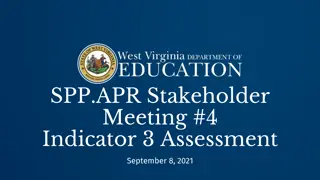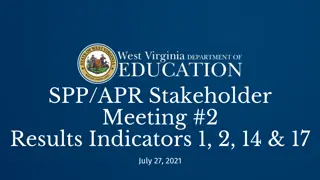Stakeholder Analysis in Project Management: Understanding and Influence
Stakeholder analysis is crucial in project management as it helps in understanding the interests and expectations of individuals and organizations involved in a project. By evaluating stakeholder expectations throughout the project lifecycle, decisions can be made to ensure stakeholder acceptance and project success. This analysis guides project promoters in making informed choices from project initiation to execution, leading to better outcomes and stakeholder relationships.
Download Presentation

Please find below an Image/Link to download the presentation.
The content on the website is provided AS IS for your information and personal use only. It may not be sold, licensed, or shared on other websites without obtaining consent from the author. Download presentation by click this link. If you encounter any issues during the download, it is possible that the publisher has removed the file from their server.
E N D
Presentation Transcript
Stakeholder Analysis J rn Vatn Based on Bj rn Andersen: COMPENDIUM IN TPK5110 QUALITY AND RISK MANAGEMENT IN PROJECTS
Definition: Stakeholders PMI, (1996): Individuals and organizations who are actively involved in the project, or whose interests may be positively or negatively affected as a result of project execution or successful project completion.
Stakeholder analysis Overall idea First of all, it allows the promoters to understand the climate for the project and the main goals of it. Should the stakeholder environment prove overwhelmingly negative already at this stage, the best solution might be to close the project right away, or at least postpone it. If the decision is to initiate discussions about choice of concept and design of the project, understanding of the expectations held by the various stakeholders regarding the outcomes of the project is valuable. This knowledge can be used to directly influence the design of the alternative concepts to maximize the likelihood of stakeholder acceptance. When evaluating different competing alternative concepts, the stakeholder expectations can be used as evaluation criteria, at least as a subset of the overall criteria employed. A concept that scores well for many important stakeholders and hopefully also does not go against expectations of others, should be a good choice. Into the engineering phase, when work is aimed at developing detailed solutions for the chosen concept, the understanding of the stakeholder requirements can help decide on specific designs. Throughout the execution phase, there are numerous decisions to be made that are eased by the stakeholder analysis understanding, e.g., choice of contractors, remuneration policies, communication with the surroundings, etc.
Facts: New high speed line Trondheim - Oslo Investment cost 100 billion NOKs Base case Traveling time: 2 hours Departure frequency: 1 hour 20 minutes Avg. feeder time: 45 minutes Cost (today): 965 NOK per travel Base case is 30% faster than airborne traffic 50% cheaper
Facts: New high speed line Trondheim - Oslo Prognosis marked shares for train
Identify stakeholders: New high speed line Trondheim - Oslo
Identify stakeholders: New high speed line Trondheim - Oslo Municipalities Travellers Government / Jernbanedirektortatet Airlines Travel agencies Investors Railway operator Infrastructure manager (Bane NOR) Construction companies Land owners Environmental groups Other organizations
Matrix for classifying stakeholders Supportive: Should be involved in relevant discussions and decisions Marginal: Should simply be monitored Non-supportive: Use a defensive strategy and minimize the dependency on the stakeholder Mixed blessing: Best handled through cooperation
Classifying stakeholders Stakeholder Media Green movement Travelers Impact Cooperation Type
Alternatives: New high speed line Trondheim - Oslo 1. sterdalen Few stops, e.g., R ros, Hamar, Gardermoen 2. Guldbrandsdalen Oppdal, Domb s, Otta, Lillehammer, Hamar, Gardermoen Domb s, Lillehammer, Gardermoen
Stakeholder analysis Green movement 1. Identify 2. Insight 3. Understand 4. Anticipate 5. Plan & act
Stakeholder analysis Mayor Otta 1. Identify 2. Insight 3. Understand 4. Anticipate 5. Plan & act
Stakeholders classified according to power, attitude, and interest
Savior; powerful, high interest, positive attitude or alternatively influential, active backer. Pay attention; you should do whatever necessary to keep them on your side - pander to their needs. Friend; low power, high interest, positive attitude or alternatively insignificant, active backer. Use him or her as a confidant or sounding board. Saboteur; powerful, high interest, negative attitude or alternatively influential, active blocker. Engage in order to disengage. You should be prepared to clean-up after them . Irritant; low power, high interest, negative attitude or alternatively insignificant, active blocker. Engage so that they stop eating away and then be put back in their box . Sleeping Giant; powerful, low interest positive attitude or alternatively influential, passive backer. Engage in order to awaken them. Acquaintance; low power, low interest, positive attitude or alternatively insignificant, passive backer. Keep them informed and communicate with on a transmit only basis. Time Bomb; powerful, low interest, negative attitude or alternatively influential, passive blocker. Need to be understood so they can be defused before the bomb goes off . Trip Wire; low power, low interest, negative attitude or alternatively insignificant, passive blocker. Try to understand so you can watch your step and avoid tripping up .
The Kano model and the three types of stakeholder requirements Performance Delight Basic
Stakeholder needs and expectation Stakeholder Financial supporters Category Mixed blessing Basic Performance Delight
Example 2 NTNU Campus project Move Dragvoll to Gl shaugen Integrate Kalvskinnet with the New NTNU
Classifying stakeholders Stakeholder Students Administration Municipality of Trondheim Professors Construction companies Impact Cooperation Type
Stakeholder needs and expectation Stakeholder Students Administration Municipality of Trondheim Professors Construction companies Category Basic Performance Delight
Exam 2013 You work for a large infrastructure construction company, and you are the designated project manager for an initiative to design and execute a PPP (public-private partnership) project upgrade the main road from Trondheim to Oppdal (E6). Such a project, under a PPP regime, has been discussed for some time by the authorities, and it seems likely there will be an open tender competition in one year s time to select a partner or group of partners to develop this project. Such a PPP project means that the selected partner will secure private financing to build the road, own and operate (meaning bearing all maintenance and operational costs as well as collecting all the income Autopass ) the road for an extended period of time, probably 20-30 years, before the road is transferred to the state for free.
At this preliminary stage in the project, you are asked to: Identify possible stakeholders you will have to deal with in such a project. Identify stakeholders that have a high impact potential to the project and high potential for cooperation. The Kano model recognizes three types of stakeholder requirements (basic requirements, expressed performance, and delight/satisfaction). Briefly discuss these types of requirements, and give 2-3 examples for each type (related to the stakeholders you have identified).























